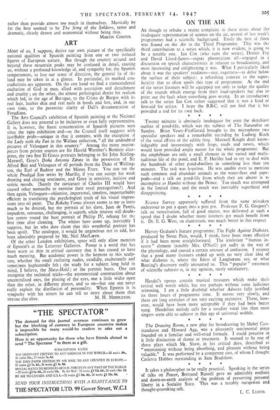ART
MOST of us, I suppose, derive our own picture of the specifically national qualities of Spanish painting from one or two isolated
figures of European stature. But though the country around and beyond these mountain peaks may be confused in detail, causing us, without a profound knowledge of, and sympathy for, the Spanish temperament, to lose our sense of direction, the general lie of the land may be taken in at a glance. In particular, its marked con- tradictions are apparent. On the one hand we find a transcendental exaltation of God in man, allied with asceticism and detachment and cruelty ; on the other, the almost pathological desire for realism which led, in the age of Baroque, to the Cristo de Burgos with its real hair, leather skin and real nails in hands and feet, and, in our own time, to the paranoiac clarity of Dali's documentation of Freudiana.
The Arts Council's exhibition of Spanish painting at the National Gallery does not pretend to be inclusive or even fully representative.
It is, hcwever, the finest concentration of Spanish pictures seen since the 1920 exhibition and—as the Council itself suggests with justifiable pride—unique in that it contains, with the exception of the Lady with the Fan in the Wallace collection, "all the undoubted pictures of Velasquez in this country." Among the many master- pieces from private sources are Sir Harold Wernher's Bermejo altar- piece, the two fine El Greco portraits belonging to Sir John Stirling- Maxwell, Goya's Dona Antonia Zdrate in the possession of Sir Alfred Beit and Velasquez of all periods from the Duke of Welling- ton, the Earl of Radnor and the Misses Frere. You can see the Whole Prodigal Son series by Murillo, if you can accept his weak drawing and cloying sentiment, and Goya in sensitive, incisive and satiric moods. (Surely the caricature of Charles III would have caused other monarchs to exercise their royal prerogatives?) And then again, Velasquez—objective, impersonal, timeless, imperturbably efficient in translating the psychological truth of his visual impres- sions into oil paint. The Rokeby Venus always seems to me to leave much to be desired, but the portrait of his slave, Juan de Pareja, impudent, sensuous, challenging, is superb, while interest will doubt- less centre round the bust portrait of Philip IV, rehung for the first time after cleaning. The whites have come up, inevitably I suppose, but let who dare claim that this wonderful portrait has been spoilt. The catalogue, it would be ungracious not to add, has been admirably prepared by Mr. Neil MacLaren. Of the other London exhibitions, space will only allow mention of Epstein's at the Leicester Galleries. Power is a word that has been worn so thin in critical currency that it has ceased to have much meaning. But academic power is the keynote to this sculp- ture, whether the small reclining nudes, candidly, exuberantly and sometimes haphazardly felt the study for a subject long held in mind, I believe, the Slave-I.-fold ; or the portrait busts. One can recognise the technical tricks—the asymmetrical construction about uncentralised axes, the placing of the eyes, one a little wider open than the other, in different planes, and so on—but one can never really explain the distillation of personality. When Epstein is in sympathy with his sitters he can tell us more about them than


































 Previous page
Previous page